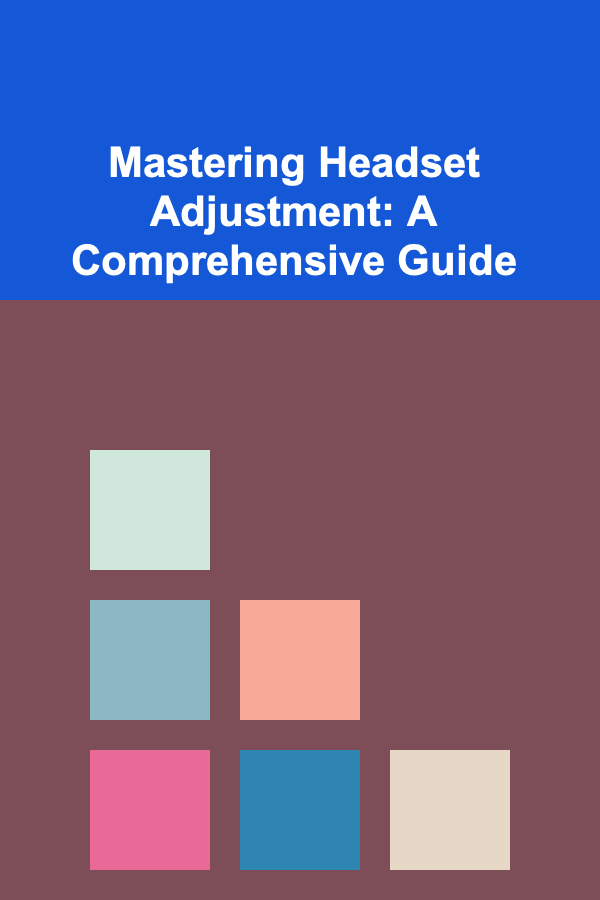
Mastering Headset Adjustment: A Comprehensive Guide
ebook include PDF & Audio bundle (Micro Guide)
$12.99$6.99
Limited Time Offer! Order within the next:

The headset is a critical component of any bicycle, connecting the fork to the frame and allowing for smooth and controlled steering. A properly adjusted headset is essential for safe and efficient riding. When a headset is too loose, it can cause knocking and rattling, leading to premature wear and tear and potentially compromising handling. A headset that is too tight can bind the steering, making it difficult to turn and also causing premature wear. This comprehensive guide will walk you through the process of using a headset wrench for steering adjustments, covering everything from identifying headset types to troubleshooting common issues.
Understanding the Bicycle Headset
Before diving into the adjustment process, it's important to understand the components of a bicycle headset and how they interact. The headset essentially acts as a set of bearings that allows the fork steerer tube to rotate smoothly within the head tube of the frame.
Headset Components
- Cups: These are pressed into the top and bottom of the head tube. They provide a smooth surface for the bearings to ride on.
- Bearings: These sit inside the cups and allow the steerer tube to rotate. They can be loose ball bearings, caged ball bearings, or cartridge bearings.
- Races: The races are essentially the part of the bearing assembly that directly contacts the bearings. These are pressed onto the steerer tube (crown race at the bottom) and often are part of the adjustable top race/compression ring.
- Crown Race: This is pressed onto the bottom of the fork steerer tube. It provides a smooth surface for the lower bearings to ride on. Proper seating of the crown race is crucial.
- Top Race/Compression Ring: This sits on top of the bearings and is responsible for applying preload to the bearings. This may be a separate ring, or integrated into the adjustable top race assembly.
- Locknut (Top Nut): This secures the headset adjustment and prevents it from loosening. Often, this is part of the adjustable top race, and uses a separate, thin lock nut to secure it.
- Stem: The stem clamps onto the steerer tube and provides the attachment point for the handlebars.
- Spacers: These are used to adjust the height of the stem on the steerer tube.
- Top Cap and Bolt: These are used to pre-load the headset bearings before the stem bolts are tightened. This system is typically used with threadless headsets.
Types of Headsets
There are primarily two types of headsets you'll encounter: threaded and threadless. More recently, integrated headsets have become common. Understanding the differences is key to proper adjustment.
- Threaded Headsets: These are commonly found on older bikes and some modern retro-styled bikes. The steerer tube is threaded, and the adjustable top race (with integrated locknut) screws onto this threading.
- Threadless Headsets (Aheadset): This is the most common type found on modern bikes. The steerer tube is not threaded. Preload is adjusted via a top cap and bolt that pulls upwards on the fork, and then the stem bolts are tightened to clamp the stem onto the steerer tube.
- Integrated Headsets: In this design, the headset bearings sit directly into the frame's head tube without separate cups being pressed in. The bearings are often cartridge bearings. This design reduces weight and simplifies installation. Adjustment is similar to threadless headsets, relying on a top cap and bolt for preload.
Tools Needed
Before you begin, gather the necessary tools:
- Headset Wrenches: Thin, specialized wrenches designed to fit the narrow locknuts on threaded headsets. Often two are needed, one to hold the adjustable top race and one to tighten the locknut. Sizes typically range from 30mm to 36mm.
- Allen Wrenches (Hex Keys): Needed for loosening stem bolts and adjusting the top cap bolt on threadless headsets. A set covering sizes from 2mm to 8mm is recommended.
- Torque Wrench: Essential for tightening bolts to the correct torque specifications, preventing damage to components.
- Grease: Apply grease to the headset bearings and threads to ensure smooth operation and prevent corrosion. Lithium grease or a specialized bicycle grease is suitable.
- Rag: For cleaning surfaces and wiping away excess grease.
- Optional: Fork Stand: While not essential, a fork stand can be helpful in supporting the fork while working on the headset, especially if removing the fork completely.
Adjusting Threaded Headsets
Adjusting a threaded headset requires careful attention to detail. Follow these steps:
-
Loosen the Stem Bolt: This is usually a bolt on the side of the stem that clamps it onto the steerer tube. Loosen it just enough to allow the stem to move freely, but don't remove it completely.
Note: On some older bikes, the stem is a quill stem that is inserted into the steerer tube and secured with a wedge bolt. In this case, loosen the wedge bolt on top of the stem a few turns, then tap it gently with a rubber mallet to loosen the wedge inside the steerer tube. -
Loosen the Headset Locknut: Use a headset wrench to loosen the locknut (the top nut) on the headset. You'll typically need two headset wrenches: one to hold the adjustable race in place while you loosen the locknut.
-
Adjust the Adjustable Race: Use a headset wrench to carefully tighten or loosen the adjustable race. The goal is to eliminate any play in the headset without overtightening it.
- To tighten the headset (reduce play), turn the adjustable race clockwise.
- To loosen the headset (reduce binding), turn the adjustable race counterclockwise.
Important: Adjust in small increments, no more than 1/8 of a turn at a time. After each adjustment, check for play by rocking the bike back and forth with the front brake applied. You should feel no knocking or looseness in the headset.
-
Tighten the Locknut: Once the headset is adjusted correctly, hold the adjustable race in place with one headset wrench and tighten the locknut against it with the other headset wrench. Tighten securely, but avoid overtightening, which can damage the threads.
-
Re-tighten the Stem Bolt: With the headset properly adjusted and the locknut tightened, re-tighten the stem bolt to the manufacturer's recommended torque specification. Use a torque wrench to ensure accurate tightening.
Caution: Over-tightening the stem bolt can damage the steerer tube or stem. -
Check for Play and Smoothness: After tightening everything, check again for play by rocking the bike back and forth with the front brake applied. Also, check for smooth steering by turning the handlebars from side to side. There should be no binding or roughness in the steering.
Adjusting Threadless Headsets (Aheadset)
Adjusting a threadless headset is a slightly different process. Here's how:
-
Loosen the Stem Bolts: Loosen the stem bolts that clamp the stem onto the steerer tube. Typically, there are two bolts, one on each side of the stem. Loosen them evenly, but don't remove them completely.
-
Loosen the Top Cap Bolt: This bolt is located on top of the stem and screws into a star-fangled nut (or similar device) inside the steerer tube. Loosen this bolt. It might already be loose, indicating that the headset needs adjustment.
-
Adjust the Preload: Now, tighten the top cap bolt. This will pull the fork upwards, pressing the bearings into the headset cups and eliminating any play. Tighten the bolt in small increments, checking for play after each adjustment.
- To tighten the headset (reduce play), tighten the top cap bolt.
- To loosen the headset (reduce binding), loosen the top cap bolt.
Important: The goal is to tighten the top cap bolt just enough to eliminate play without overtightening and causing binding. The headset should feel smooth and free when you turn the handlebars. A good test is to lift the front wheel off the ground a few inches and let the handlebars swing freely. They should swing easily from side to side without catching or stopping abruptly.
-
Tighten the Stem Bolts: Once the preload is correctly adjusted, tighten the stem bolts to the manufacturer's recommended torque specification. Use a torque wrench to ensure accurate tightening. Tighten the bolts evenly, alternating between them a little at a time.
Caution: It's crucial to tighten the stem bolts to the correct torque. Over-tightening can crush the steerer tube (especially carbon fiber steerer tubes) or damage the stem. Under-tightening can cause the stem to slip on the steerer tube, which is extremely dangerous. -
Check for Play and Smoothness: After tightening everything, check again for play by rocking the bike back and forth with the front brake applied. Also, check for smooth steering by turning the handlebars from side to side. There should be no binding or roughness in the steering.
Adjusting Integrated Headsets
Integrated headsets are adjusted in a very similar manner to threadless headsets. The key difference is that the bearings sit directly within the frame's head tube, eliminating the need for separate cups. The adjustment process still relies on a top cap and bolt to preload the bearings.
- Loosen the Stem Bolts: As with threadless headsets, begin by loosening the stem bolts that clamp the stem onto the steerer tube.
- Loosen the Top Cap Bolt: Loosen the top cap bolt.
- Adjust the Preload: Tighten the top cap bolt to adjust the preload on the bearings. Follow the same guidelines as for threadless headsets: tighten in small increments, checking for play and smoothness after each adjustment.
- Tighten the Stem Bolts: Tighten the stem bolts to the manufacturer's recommended torque specification.
- Check for Play and Smoothness: Check for play and smooth steering.
Troubleshooting Common Headset Problems
Even with careful adjustment, you may encounter some common headset problems. Here's how to troubleshoot them:
- Headset Knocking or Clicking: This usually indicates a loose headset. Re-adjust the headset according to the appropriate procedure (threaded, threadless, or integrated). If the knocking persists even after adjustment, the bearings may be worn or damaged and need to be replaced. Check also the crown race - if this is not seated properly it can lead to knocking.
- Stiff or Binding Steering: This usually indicates an overtightened headset or damaged bearings. Loosen the headset slightly. If the problem persists, the bearings may need to be cleaned, lubricated, or replaced. Check the headset cups for damage or imperfections. Also, make sure the cables aren't impeding the steering.
- Headset Won't Stay Tight: This can be caused by worn bearings, damaged threads, or a loose locknut. Replace the bearings if they are worn. If the threads are damaged on a threaded headset, the headset may need to be replaced. Ensure the locknut is tightened securely. For threadless headsets, ensure the star-fangled nut is properly installed and seated in the steerer tube. Sometimes using thread locking compound (e.g. Loctite) on the star-fangled nut before installation can help.
- Creaking Noises: Creaking noises can be difficult to pinpoint, but they often originate from the headset. Try cleaning and greasing all the headset components, including the cups, bearings, races, and stem interface. Check that the headset cups are properly pressed into the frame. Sometimes, creaking noises originate from the handlebars/stem interface, or from the fork crown/crown race interface.
- Water Entering the Headset: This can lead to corrosion and premature wear. Ensure that all headset seals are in good condition and properly installed. Consider using waterproof grease to protect the bearings.
Preventative Maintenance
To keep your headset in good working order, perform regular preventative maintenance:
- Regular Cleaning and Lubrication: Periodically clean and lubricate the headset bearings. Remove the fork and clean the bearings with a degreaser. Inspect the bearings for wear or damage. Re-grease the bearings and reassemble the headset. How often you need to do this depends on riding conditions; more frequent maintenance is needed in wet or muddy conditions.
- Inspect for Wear and Damage: Regularly inspect the headset cups, bearings, and races for wear or damage. Replace worn or damaged components as needed.
- Check Headset Adjustment: Periodically check the headset adjustment and re-adjust as needed.
- Proper Installation: When installing a new headset, ensure that all components are properly installed and aligned. Use a headset press to install the cups to avoid damaging the frame. Ensure the crown race is properly seated on the fork.
Conclusion
Adjusting a bicycle headset might seem daunting at first, but with the right tools and knowledge, it's a manageable task. By understanding the different types of headsets, following the correct adjustment procedures, and performing regular maintenance, you can ensure smooth and safe steering for years to come. If you're unsure about any part of the process, it's always best to consult a qualified bicycle mechanic. A properly adjusted headset is a vital part of a well-maintained bicycle, contributing significantly to a comfortable and confident riding experience.

How To Understand the Role of Fear in Extreme Sports
Read More
How To Plan for Philanthropy in Your FIRE Plan
Read More
How To Observe Nocturnal Birds
Read More
How To Live a Life of Meaningful Action
Read More
Investing in Biotech Stocks: A Comprehensive Guide
Read More
How to Create a Garden Checklist for Small Spaces
Read MoreOther Products

How To Understand the Role of Fear in Extreme Sports
Read More
How To Plan for Philanthropy in Your FIRE Plan
Read More
How To Observe Nocturnal Birds
Read More
How To Live a Life of Meaningful Action
Read More
Investing in Biotech Stocks: A Comprehensive Guide
Read More